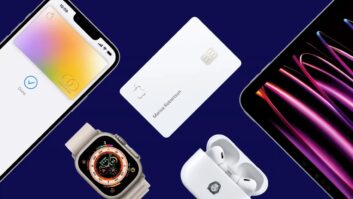Cupertino, Calif. — Apple introduced two iPhones for the first time since the original iPhone’s 2007 launch, unveiling a flagship 5S and a lower-priced 5C to segment the market.
The strategy is to accelerate the iPhone’s slowing global growth rate and post a stronger performance in developing countries where smartphones aren’t subsidized by carriers.
In the past, Apple debuted one iPhone at a time but continued to ship its previous model at a reduced price of $99 while offering an older model for free.
The new low-cost iPhone 5C and flagship 5S will be available on Sept. 20, with preorders for the 5C starting Sept. 13. The phones on Sept. 20 will be available in the U.S., Australia, Canada, China, France, Germany, Singapore, Japan and the U.K., with availability in 100 countries and 270 carriers by year’s end.
Both feature the new iOS 7 OS and access to Apple’s first music-streaming service. iOS 7 will be available for downloads to existing devices on Sept. 18. Both also feature a 4-inch widescreen display like the current iPhone 5.
The lower-cost iPhone 5C, made with a hard polycarbonate shell in five different colors, is priced at $99 for a 16GB version and $199 for a 32GB model. That’s down from the current iPhone 5 at $199 for the 16GB version and $299 for the 32GB iPhone 5.
The premium iPhone 5S will be available at the same price as the current iPhone 5 at $199 for the 16GB version, $299 for the 32GB version, and $399 for a 64GB version.
The existing 8GB 4S with iOS7 will be free.
Both phones use the iPhone 5’s 1,136 by 640 display with 326 ppi, and like the iPhone 5, both sport main 8-megapixel 1080p camera and front 1.2-megapixel 720p camera.
The iPhone 5C also features the same A6 CPU as the current iPhone 5 and is promoted as offering more LTE bands than any other smartphone, the company said.
The flagship iPhone 5S steps up to an the new A7 CPU said to be twice as fast as the iPhone 5 processor, and the phone is promoted as the first smartphone in the world with 64-bit architecture. Existing apps are backward compatible with the 64-bit architecture, but Apple has reengineered its own apps to maximize performance.
The 5S’s aluminum shell will be available in silver, gold and gray, marking the retirement of a black option. The device also features twice the graphics performance of its predecessor, and it adds Open GL/ES 3.0 for gaming, bringing console and desktop gaming performance to the iPhone.
Other new features include fingerprint sensing to unlock a phone. Called Touch ID, the fingerprint sensor makes it unnecessary to enter a passcode or swipe to use the phone. The fingerprint sensor, integrated into the hard home button, can also be used to authorize iTunes pour chases.
It also adds a dedicated M7 motion coprocessor chip to take over motion sensing from the main processor and enable a new generation of apps, including fitness apps, that recognize when you’re walking, driving or jogging.
New camera enhancements are said to deliver SLR quality with a new Apple-developed five-element camera lens featuring 15 percent larger sensor, bigger pixels to capture more light, and f/ 2.2 aperture.
The first True Tune flash adjusts the flash’s color temperature based on environmental conditions to present more natural-looking flesh tones, a 10 fps burst mode, and a 120 fps slow-motion mode. The main camera is still an 8-megapixel/1080p camera.
Neither phone features nearfield communications (NFC) technology.
With the launch of a new low-cost iPhone, Apple runs the risk of cannibalizing dollar sales of its higher priced product to a greater extent than it did by keeping its older iPhones on the market at deep discounts, some analysts said.
At the same time, the lower-cost model will build share in developing markets, especially China, which is the world’s largest market for smartphones. The low-cost model could also accelerate Apple sales in the expanding no-contract market in the U.S., analysts said.
T-Mobile could benefit in particular from a low-cost iPhone because it offers only no-contract no-subsidy phones through its direct channels and most of its indirect retailers, analysts said. When the installment-plan price of the current iPhone 5 at an unsubsidized $649 is bundled with a service plan, a user’s monthly costs approach that of other carrier’s contract payments, analysts said.
Speaking to the potential for greater cannibalization of flagship-phone sales, Gartner analyst Anshul Gupta pointed out that Apple’s average selling prices have fallen because of strong sales of previous-generation iPhones. “While Apple’s ASP demonstrates the need for a new flagship model, it is risky for Apple to introduce a new lower priced model too,” Gupta said. “Although the new low-priced phone could be priced similarly to the iPhone 4 at a cost to carriers of $300 to $400, “the potential for cannibalization will be much greater than what is seen today with the iPhone 4. Despite being seen as the less expensive sibling of the flagship product, it would represent a new device with the hype of the marketing associated with it.”
Jan Dawson, chief telecoms analyst at Ovum, said a lower-cost iPhone, coupled with an expected deal to sell into China’s largest carrier, “are both key” to reversing slower iPhone growth rates, which he attributed not only to Apple’s larger sales base but is also “driven by Apple’s increasing saturation of its addressable market.” A cheaper iPhone “is critical for expanding the addressable market because many people in China and elsewhere simply cannot afford to buy a current generation iPhone, especially when it’s not subsidized.”
The trick will be to prevent the lower-cost iPhone from becoming so popular that Apple’s iPhone ASPs are further reduced, in turn squeezing margins. “The trick for Apple is to position a cheaper device so that it’s attractive for those that haven’t been able to afford an iPhone before but is missing enough key features for the new flagship iPhone to remain compelling.” It also means “figuring out how to make the lower-cost variant feel like a real iPhone while stripping out significant cost” to hold margins, he said.
Globally, Apple is losing share in sales of smartphones to end users, with Apple’s global second-quarter unit share falling to 18.8 percent from a year-ago 14.2 percent. That is even though Apple’s unit sales rose 10.2 percent to 32 million units, Gartner found.
In the U.S., however, Apple has gained smartphone share, ComScore reported. For the three months ending May, Apple’s share of the smartphone user base has risen faster than Android’s share. Apple’s share rose to 39.2 percent from the year-ago 31.9 percent, while Android’s share rose to 52.4 percent from 50.9 percent.
Although Apple’s global iPhone sales are up, the growth rate has slowed down, Apple’s third-quarter financial report showed. Nine-month unit sales grew only 18.7 percent to 116.5 million on dollar growth of 13.3 percent to $71.8 billion during the period. In contrast, iPhone sales for the full 2012 fiscal year grew 73 percent in units to 125 million and 71 percent in dollars to $80.5 billion.













